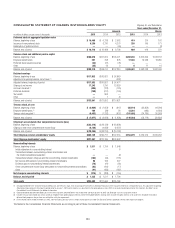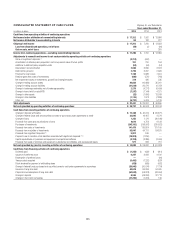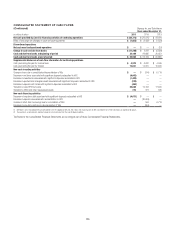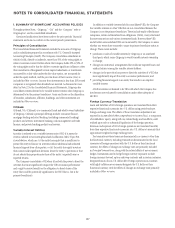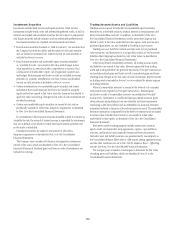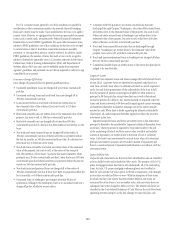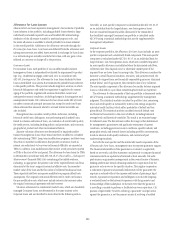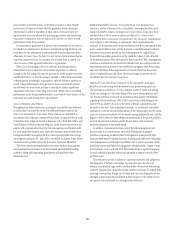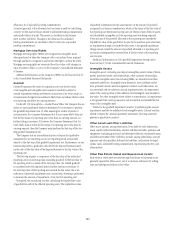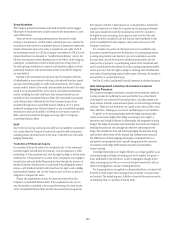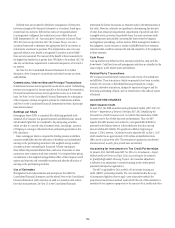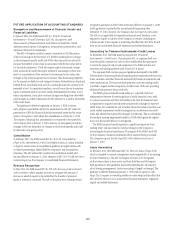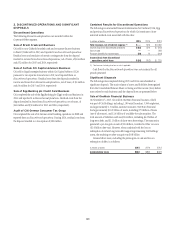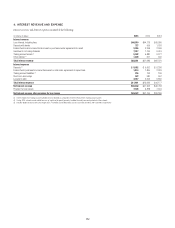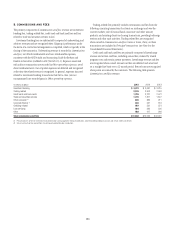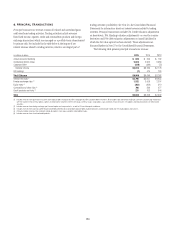Citibank 2015 Annual Report Download - page 162
Download and view the complete annual report
Please find page 162 of the 2015 Citibank annual report below. You can navigate through the pages in the report by either clicking on the pages listed below, or by using the keyword search tool below to find specific information within the annual report.144
Securitizations
The Company primarily securitizes credit card receivables and mortgages.
Other types of securitized assets include corporate debt instruments (in cash
and synthetic form).
There are two key accounting determinations that must be made
relating to securitizations. Citi first makes a determination as to whether the
securitization entity must be consolidated. Second, it determines whether the
transfer of financial assets to the entity is considered a sale under GAAP. If
the securitization entity is a VIE, the Company consolidates the VIE if it is the
primary beneficiary (as discussed in “Variable Interest Entities” above). For
all other securitization entities determined not to be VIEs in which Citigroup
participates, consolidation is based on which party has voting control of
the entity, giving consideration to removal and liquidation rights in certain
partnership structures. Only securitization entities controlled by Citigroup
are consolidated.
Interests in the securitized and sold assets may be retained in the form
of subordinated or senior interest-only strips, subordinated tranches, spread
accounts and servicing rights. In credit card securitizations, the Company
retains a seller’s interest in the credit card receivables transferred to the trusts,
which is not in securitized form. In the case of consolidated securitization
entities, including the credit card trusts, these retained interests are not
reported on Citi’s Consolidated Balance Sheet. The securitized loans remain
on the balance sheet. Substantially all of the Consumer loans sold or
securitized through non-consolidated trusts by Citigroup are U.S. prime
residential mortgage loans. Retained interests in non-consolidated mortgage
securitization trusts are classified as Trading account assets, except for
MSRs, which are included in Mortgage servicing rights on Citigroup’s
Consolidated Balance Sheet.
Debt
Short-term borrowings and Long-term debt are accounted for at amortized
cost, except where the Company has elected to report the debt instruments,
including certain structured notes at fair value, or the debt is in a fair value
hedging relationship.
Transfers of Financial Assets
For a transfer of financial assets to be considered a sale: (i) the assets must
have been legally isolated from the Company, even in bankruptcy or other
receivership; (ii) the purchaser must have the right to pledge or sell the assets
transferred or, if the purchaser is an entity whose sole purpose is to engage in
securitization and asset-backed financing activities through the issuance of
beneficial interests and that entity is constrained from pledging the assets it
receives, each beneficial interest holder must have the right to sell or pledge
their beneficial interests; and (iii) the Company may not have an option or
obligation to reacquire the assets.
If these sale requirements are met, the assets are removed from the
Company’s Consolidated Balance Sheet. If the conditions for sale are not
met, the transfer is considered to be a secured borrowing, the assets remain
on the Consolidated Balance Sheet and the sale proceeds are recognized as
the Company’s liability. A legal opinion on a sale generally is obtained for
complex transactions or where the Company has continuing involvement
with assets transferred or with the securitization entity. For a transfer to
be eligible for sale accounting, those opinions must state that the asset
transfer would be considered a sale and that the assets transferred would
not be consolidated with the Company’s other assets in the event of the
Company’s insolvency.
For a transfer of a portion of a financial asset to be considered a sale,
the portion transferred must meet the definition of a participating interest.
A participating interest must represent a pro rata ownership in an entire
financial asset; all cash flows must be divided proportionately, with the
same priority of payment; no participating interest in the transferred asset
may be subordinated to the interest of another participating interest holder;
and no party may have the right to pledge or exchange the entire financial
asset unless all participating interest holders agree. Otherwise, the transfer is
accounted for as a secured borrowing.
See Note 22 to the Consolidated Financial Statements for further discussion.
Risk Management Activities—Derivatives Used for
Hedging Purposes
The Company manages its exposures to market rate movements outside its
trading activities by modifying the asset and liability mix, either directly
or through the use of derivative financial products, including interest-rate
swaps, futures, forwards, and purchased options, as well as foreign-exchange
contracts. These end-user derivatives are carried at fair value in Other assets,
Other liabilities, Trading account assets and Trading account liabilities.
To qualify as an accounting hedge under the hedge accounting rules
(versus an economic hedge where hedge accounting is not sought), a
derivative must be highly effective in offsetting the risk designated as being
hedged. The hedge relationship must be formally documented at inception,
detailing the particular risk management objective and strategy for the
hedge. This includes the item and risk being hedged, the derivative being
used and how effectiveness will be assessed and ineffectiveness measured.
The effectiveness of these hedging relationships is evaluated both on a
retrospective and prospective basis, typically using quantitative measures
of correlation with hedge ineffectiveness measured and recorded in
current earnings.
If a hedge relationship is not highly effective, it no longer qualifies as an
accounting hedge and hedge accounting may not be applied. Any gains or
losses attributable to the derivatives, as well as subsequent changes in fair
value, are recognized in Other revenue or Principal transactions with no
offset to the hedged item, similar to trading derivatives.
The foregoing criteria are applied on a decentralized basis, consistent with
the level at which market risk is managed, but are subject to various limits
and controls. The underlying asset, liability or forecasted transaction may be
an individual item or a portfolio of similar items.


